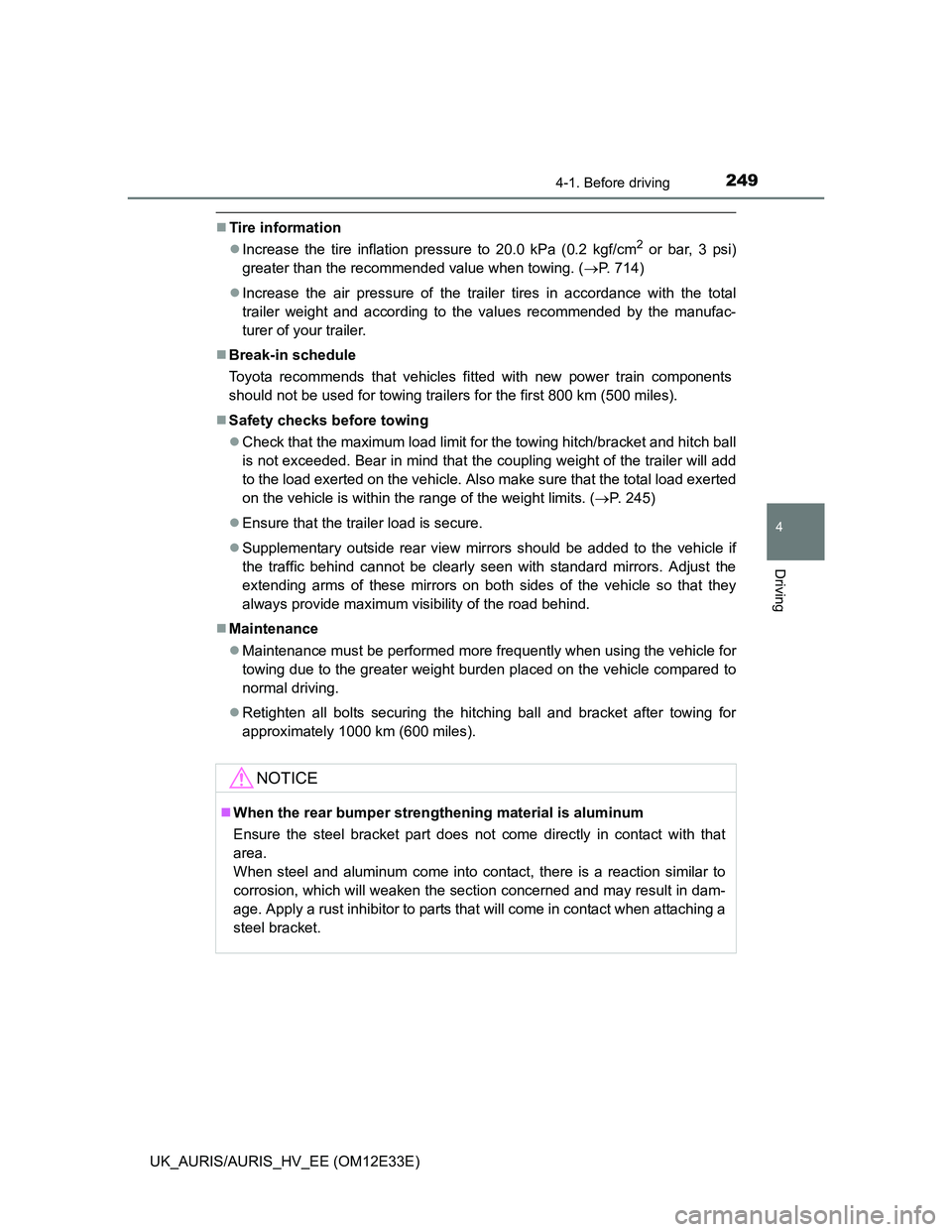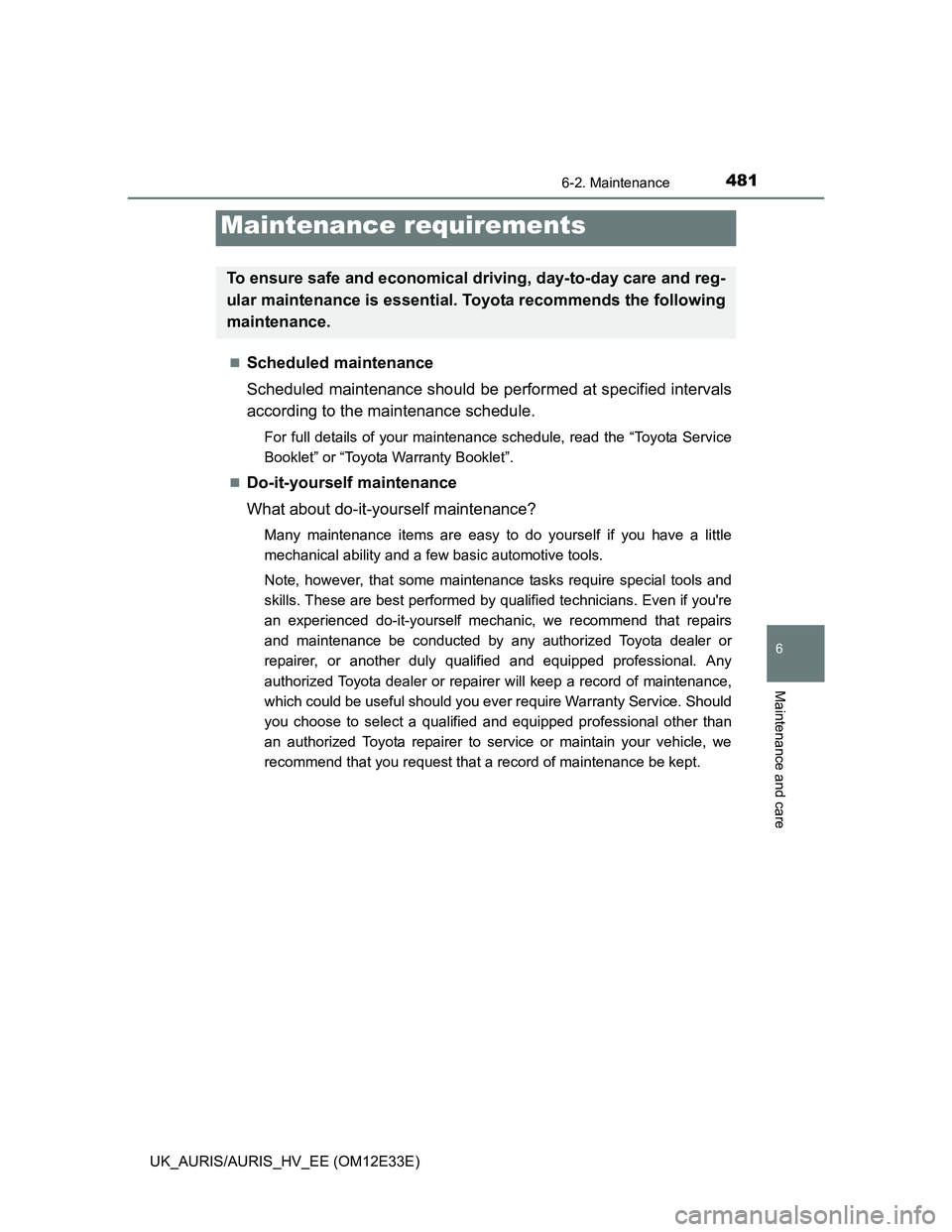Page 251 of 750

2494-1. Before driving
UK_AURIS/AURIS_HV_EE (OM12E33E)
4
Driving
Tire information
Increase the tire inflation pressure to 20.0 kPa (0.2 kgf/cm
2 or bar, 3 psi)
greater than the recommended value when towing. (P. 714)
Increase the air pressure of the trailer tires in accordance with the total
trailer weight and according to the values recommended by the manufac-
turer of your trailer.
Break-in schedule
Toyota recommends that vehicles fitted with new power train components
should not be used for towing trailers for the first 800 km (500 miles).
Safety checks before towing
Check that the maximum load limit for the towing hitch/bracket and hitch ball
is not exceeded. Bear in mind that the coupling weight of the trailer will add
to the load exerted on the vehicle. Also make sure that the total load exerted
on the vehicle is within the range of the weight limits. (P. 245)
Ensure that the trailer load is secure.
Supplementary outside rear view mirrors should be added to the vehicle if
the traffic behind cannot be clearly seen with standard mirrors. Adjust the
extending arms of these mirrors on both sides of the vehicle so that they
always provide maximum visibility of the road behind.
Maintenance
Maintenance must be performed more frequently when using the vehicle for
towing due to the greater weight burden placed on the vehicle compared to
normal driving.
Retighten all bolts securing the hitching ball and bracket after towing for
approximately 1000 km (600 miles).
NOTICE
When the rear bumper strengthening material is aluminum
Ensure the steel bracket part does not come directly in contact with that
area.
When steel and aluminum come into contact, there is a reaction similar to
corrosion, which will weaken the section concerned and may result in dam-
age. Apply a rust inhibitor to parts that will come in contact when attaching a
steel bracket.
Page 483 of 750

481
UK_AURIS/AURIS_HV_EE (OM12E33E)
6
Maintenance and care
6-2. Maintenance
Scheduled maintenance
Scheduled maintenance should be performed at specified intervals
according to the maintenance schedule.
For full details of your maintenance schedule, read the “Toyota Service
Booklet” or “Toyota Warranty Booklet”.
Do-it-yourself maintenance
What about do-it-yourself maintenance?
Many maintenance items are easy to do yourself if you have a little
mechanical ability and a few basic automotive tools.
Note, however, that some maintenance tasks require special tools and
skills. These are best performed by qualified technicians. Even if you're
an experienced do-it-yourself mechanic, we recommend that repairs
and maintenance be conducted by any authorized Toyota dealer or
repairer, or another duly qualified and equipped professional. Any
authorized Toyota dealer or repairer will keep a record of maintenance,
which could be useful should you ever require Warranty Service. Should
you choose to select a qualified and equipped professional other than
an authorized Toyota repairer to service or maintain your vehicle, we
recommend that you request that a record of maintenance be kept.
Maintenance requirements
To ensure safe and economical driving, day-to-day care and reg-
ular maintenance is essential. Toyota recommends the following
maintenance.
Page 484 of 750

4826-2. Maintenance
UK_AURIS/AURIS_HV_EE (OM12E33E)
Where to go for service?
In order to maintain your vehicle in the highest possible condition, Toyota rec-
ommends that all repairs and service operations be carried out by authorized
Toyota dealers or repairers or other duly qualified and equipped profession-
als. For repairs and services covered by your warranty, please visit an autho-
rized Toyota dealer or repairer, who will use genuine Toyota parts in repairing
any difficulties you may encounter. There can also be advantages in utilizing
authorized Toyota dealers or repairers for non-warranty repairs and services,
as members of the Toyota network will be able to expertly assist you with any
difficulties you may encounter.
Your Toyota dealer or repairer, or another duly qualified and equipped profes-
sional will perform all of the scheduled maintenance on your vehicle reliably
and economically due to their experience with Toyota vehicles.
Does your vehicle need repair?
Be on the alert for changes in performance and sounds, and visual tip-offs
that indicate service is needed. Some important clues are:
Engine missing, stumbling, or pinging
Appreciable loss of power
Strange engine noises
A fluid leak under the vehicle (However, water dripping from the air condi-
tioning after use is normal.)
Change in exhaust sound (This may indicate a dangerous carbon monoxide
leak. Drive with the windows open and have the exhaust system checked
immediately.)
Flat-looking tires, excessive tire squeal when cornering, uneven tire wear
Vehicle pulls to one side when driving straight on a level road
Strange noises related to suspension movement
Loss of brake effectiveness, spongy feeling brake pedal or clutch pedal
(vehicles with a manual transmission), pedal almost touches the floor, vehi-
cle pulls to one side when braking
Engine coolant temperature continually higher than normal
If you notice any of these clues, take your vehicle to any authorized Toyota
dealer or repairer, or another duly qualified and equipped professional, as
soon as possible. Your vehicle may need adjustment or repair.
Page 529 of 750
5276-3. Do-it-yourself maintenance
UK_AURIS/AURIS_HV_EE (OM12E33E)
6
Maintenance and care
Remove the filter cover.
Left-hand drive vehicles
Right-hand drive vehicles
Replacement method
Remove the air conditioning filter
and replace it with a new one.
The “UP” marks shown on the fil-
ter should be pointing up.
Checking interval
Inspect and replace the air conditioning filter according to the maintenance
schedule. In dusty areas or areas with heavy traffic flow, early replacement
may be required. (For scheduled maintenance information, please refer to the
“Toyota Service Booklet” or “Toyota Warranty Booklet”.)
If air flow from the vents decreases dramatically
The filter may be clogged. Check the filter and replace if necessary.
4
Page 606 of 750
6047-2. Steps to take in an emergency
UK_AURIS/AURIS_HV_EE (OM12E33E)
Indicates that the
driver’s door was
opened with the shift
position in any position
other than P
A buzzer also
sounds.
Shift the shift position
to P.
Indicates that engine oil
level is low.
A buzzer also
sounds.Check the level of
engine oil, and add if
necessary.
Indicates that the
engine oil is scheduled
to be changed.
Comes on approxi-
mately 14500 km
(9000 miles) after the
engine oil is
changed. (The indi-
cator will not work
properly unless the
oil maintenance data
has been reset.)
Check the engine oil,
and change if neces-
sary. After changing the
engine oil, the oil
change system should
be reset. (P. 503)
Warning messageDetailsCorrection procedure
(Flashes)
(Vehicles with a Multid-
rive)
(Diesel engine)
(Diesel engine)